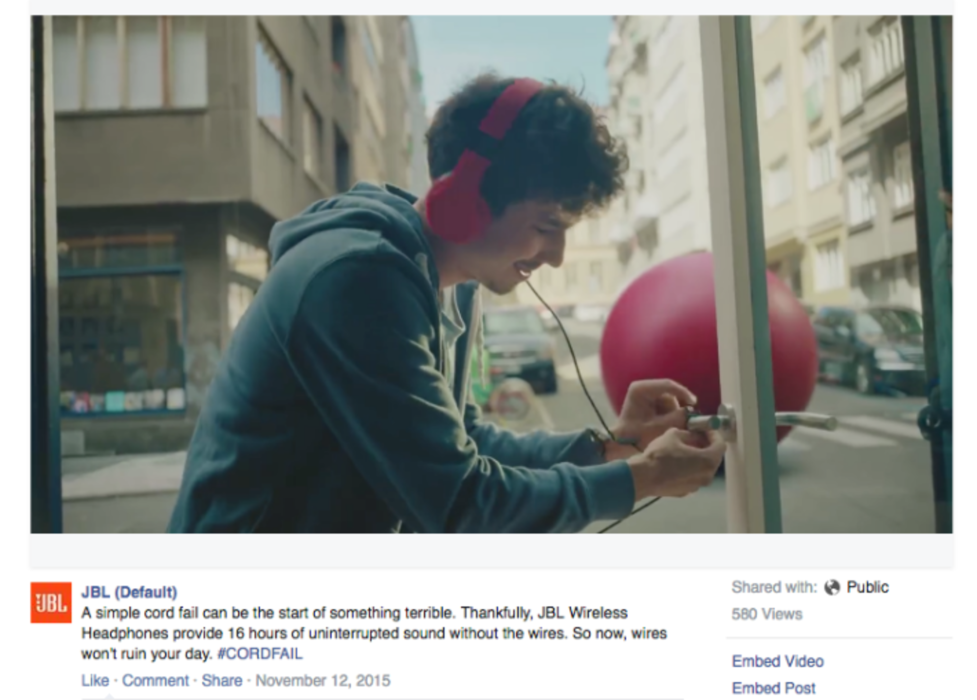The best gift marketers can give their customers is value, and delivering content in a contextual atmosphere is one way they can tie this value up in a relevant bow. Harman International Industries—a connected products provider for automakers, consumers, and businesses—proved this to be true when it paired sequential messaging with digital and social retargeting for its holiday campaign.
Setting the stage
JBL is a 70-year-old, Harman-owned consumer electronic goods brand. And until recently, its marketing department hadn’t caught up with the times. Dave Spinato, global director of digital and social media at Harman, admits that marketing hadn’t been a top priority for the parent company until 2013, when it hired Ralph Santana to serve as CMO and grow the marketing team.
“The company has traditionally been based on sales guys and engineers,” Spinato explains. “It’s not that there was never any marketing within the organization. It just had some ups and downs.”
Harman’s marketers had a “laundry list” of goals they wanted to achieve, including increase brand awareness, consumer product recognition, purchase, and engagement. As Spinato puts it, “We want to do it all.”
To help achieve these goals, Harman’s marketers started working with full-service media agency BPN in October and brought on media buying solution provider Adaptly a month later. Since nearly 70% of direct online sales for Harman’s lifestyle consumer products occur during the holiday season (and JBL leads these sales), the company’s marketers decided to launch a campaign for JBL that November.
Knowing that they had a tight timeframe to strategize and execute a holiday campaign, Harman’s marketers decided to rely on what they had available—an archive of content full of videos, product images, and use cases. Sean O’Neal, president of Adaptly, says the team chose to use this content to tell the JBL story and send sequential messages that would guide customers down the path to purchase.
Producing the campaign
Harman’s marketers took its existing content and produced video ads that were distributed across Facebook, Instagram, and Twitter. These video ads ranged from product videos to sponsorship clips and complemented the brand’s TV spots.
After Harman’s marketers made consumers aware of the JBL brand, it re-engaged them through link-ads, which were distributed through the same social channels. These ads contained “fun, snackable” content, Spinato says, and linked back to the Harman website to encourage engagement and purchase. He also says that the company’s marketers tracked key social behaviors—such as likes, views, shares, posts, or comments—and assigned ranks to each one to determine which pieces of content performed the best.
“If somebody shares a piece of content, that’s going to get a higher score than if somebody just likes it,” he explains.
Finally, once consumers engaged with Harman’s content, the company’s marketers tried to convert them by showing them additional link ads and carousel ads—which O’Neal describes as “mini catalog” social ads that consumers can flip through to see different items and click directly to their product pages.
Targeting the right audiences
Harman’s marketers leveraged Custom Audiences on Facebook at each stage of the campaign. This tool allowed them to match the customers in their database to Facebook accounts, segment them, and serve them targeted content. They could also identify Web visitors by installing a pixel on JBL’s Web page and remarketing to them when they revisited Facebook and Twitter. For the campaign, Harman’s marketers retargeted Web visitors and those who viewed or engaged with a video ad.
But Harman’s marketers didn’t just target existing customers. It also reached out to new prospects that resembled its current base through lookalike modeling—a technique that enables marketers to identify consumers who have similar attributes to their existing base (e.g. demographics, interests) and target them.
Connecting the off and online worlds
In addition to reaching customers through digital and social channels, Harman targeted customers through the mobile and physical environments. To drive Black Friday visits to its New York flagship store, Harman’s marketers leveraged geofencing and sent consumers “free gift with purchase” offers when they came within a certain radius of the store and were on a partnering site within a mobile ad network, like Yelp.
Calculating the results
The holiday campaign ran from November to January, with each phase running approximately two to three weeks. And although Harman’s marketers had to race against the clock to pull the campaign together, the results suggest that it was well worth it.
There were 4.7 million views of JBL’s social videos, including 507,000 completed views, during the lead-up to Black Friday. As for the campaign as a whole, all of the ads reached 14 million people, and the posts generated 3.3 million engagements. What’s more, Harman saw a 50% increase in year-over-year direct e-commerce sales. Still, Spinato considers executing the campaign on time while deriving insights his biggest success metric.
“There are times [when] you just need to rush to get something done,” he says. “And if you aren’t getting any learnings, then it’s frankly a waste.”
Harman’s marketers have continued to grow their digital and social capabilities. For instance, Spinato says that the company is currently testing a new Twitter capability that’s similar to a Facebook link ad or display ad. He also says that he hopes to create more strategic and customizable content for the next holiday season.
As for marketers looking to replicate Harman’s success, Spinato encourages them to target customers not only based on their demographics but also based on their behaviors; then test.
Perhaps he summarizes it best: “[It’s] saying the right thing to the right person, at the right time.”







